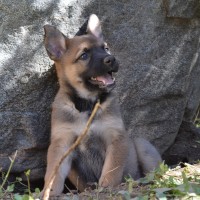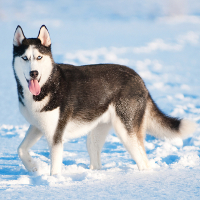Appearance of the Belusky
|
| The Belusky is a medium-sized dog with a compact, solid body, 58.5 to 63.5 centimeters high at the shoulders, weighing between 20.5 and 29.5 kilos. The Belusky coat is short to medium-length, water-resistant, with layers of soft, rough and hard hair, creating a dense double-layered coat. They can come in virtually any color with black or white markings. The ears are erect, can be darker or black and, depending on dominant parental genes, can be larger like the Belgian Malinois Shepherd or smaller and rounder like the Siberian Husky. The tail is brush-like and long, and the hair may be longer on the hindquarters if the Belgian Malinois is dominant. The head may look more like the thicker, rounder Siberian Husky, or may resemble the flatter, finer structure and longer muzzle of the Belgian Malinois Shepherd, depending on the genes of the dominant parents. The eyes may take on the slightly almond-shaped Belgian chocolate color of the Belgian Shepherd Malinois parent, or the almond-shaped brown or blue of the Siberian Husky parent, displaying the alert, intelligent, questioning expression of the Malinois parent, or the lively, friendly, mischievous expression of the Husky parent. Both parent breeds boast a scissor bite without the appearance of pink gums. Legs can take on the clean, compact legs of the Husky parent or the strong, medium-length metatarsals of the Malinois parent. |
Temperament of the Belusky
|
| The Belusky temperament can be a blend of the personality traits of the Malinois, providing the aggression and herding tendencies, and the Husky side, the gentle, independent and loving tendencies. The end result of this mix of breeds is a friendly, extremely active and intelligent canine breed that is easier to train due to the Belgian Shepherd Malinois genes as opposed to the stubbornness and casual attitude of the Siberian Husky, which makes the latter much more difficult to train. The Husky side loves everyone, regardless of age or purpose, and is good with other dogs. The Malinois side is a herding dog at heart, loyal to its human family and quite protective. Herding aggression and protective tendencies require that puppies be introduced to all types of people as early as possible to avoid inappropriate protective issues as they grow. This also makes it important to discourage herding behaviors, such as nipping at the heels of other animals and humans to keep them in line, as early in life as possible and continuing with consistency as they mature. Both parent breeds are extremely active dogs and require a lot of exercise, most likely 1 to 2 hours a day minimum with an appropriate opportunity to run daily. |
Needs and activities of the Belusky
|
| Your Belusky will need at least 1 to 2 hours of exercise every day. This can include walking, running and frisbee hunting. They love to hunt and play with different types of toys, with running and jumping at the top of their list of favorite activities. To keep your Belusky healthy, fit and happy, exercise it for at least 1-2 hours a day. Because of their need for plenty of exercise, hybrids are not well suited to apartment living. He'll be happiest in a home with a large fenced yard, but make sure the fence is high enough and diggable because both parent breeds are riders and the Husky parent brings impressive digging skills, enabling them to tunnel under fences and gates to satisfy the breed's inherent wanderlust. Keeping these things in mind, your Belusky can live in urban or rural communities as long as it has ample opportunity for exercise. Your Belusky can live in almost any climate, with a dense, multi-layered coat that repels water and protects them in the coldest and hottest environments. |
Maintenance of the Belusky
|
| The Belusky hybrid canine breed is relatively low maintenance, requiring brushing once or twice a week, especially during their normal shedding seasons which may require more frequent brushing to control loose hair. This is particularly important for households with family members sensitive to dog hair, or with respiratory or asthmatic problems, as they are not hypoallergenic. Bathing is done on an as-needed basis. They generally don't have that doggy smell. As with all canine breeds, routine teeth cleaning and examinations protect against periodontal disease and tooth loss. Weekly ear checks should be performed to keep the ears clean and free from infection. |









 English (United Kingdom)
English (United Kingdom)